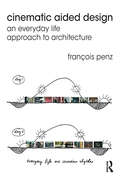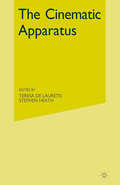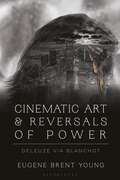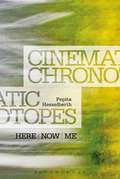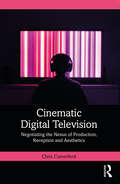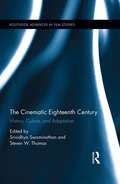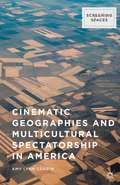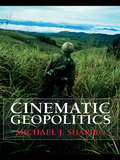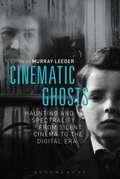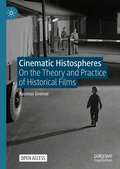- Table View
- List View
Cinematic Aided Design: An Everyday Life Approach to Architecture
by François PenzCinematic Aided Design: An Everyday Life Approach to Architecture provides architects, planners, designer practitioners, politicians and decision makers with a new awareness of the practice of everyday life through the medium of film. This novel approach will also appeal to film scholars and film practitioners with an interest in spatial and architectural issues, as well as researchers from cultural studies in the field of everyday life. The everyday life is one of the hardest things to uncover since by its very nature it remains overlooked and ignored. However, cinema has over the last 120 years represented, interpreted and portrayed hundreds of thousands of everyday life situations taking place in a wide range of dwellings, streets and cities. Film constitutes the most comprehensive lived in building data in existence. Cinema created a comprehensive encyclopedia of architectural spaces and building elements. It has exposed large fragments of our everyday life and everyday environment that this book is aiming to reveal and restitute.
Cinematic Art and Reversals of Power: Deleuze via Blanchot
by Eugene B. YoungBringing together Deleuze, Blanchot, and Foucault, this book provides a detailed and original exploration of the ideas that influenced Deleuze's thought leading up to and throughout his cinema volumes and, as a result, proposes a new definition of art. Examining Blanchot's suggestion that art and dream are “outside” of power, as imagination has neither reality nor truth, and Foucault's theory that power forms knowledge by valuing life, Eugene Brent Young relates these to both Deleuze's philosophy of time and his work with Guattari on art. In doing so, he uses case studies from literature and popular film, including Kafka's Castle, Villeneuve's Arrival, and Kubrick's Eyes Wide Shut. Providing important new insights for those working in literary and cinematic studies, this book advances a new definition of art as that which reverses the realities and truths of power to express obscure ideas and values beyond both our exterior and interior worlds.
Cinematic Art and Reversals of Power: Deleuze via Blanchot
by Eugene B. YoungBringing together Deleuze, Blanchot, and Foucault, this book provides a detailed and original exploration of the ideas that influenced Deleuze's thought leading up to and throughout his cinema volumes and, as a result, proposes a new definition of art. Examining Blanchot's suggestion that art and dream are “outside” of power, as imagination has neither reality nor truth, and Foucault's theory that power forms knowledge by valuing life, Eugene Brent Young relates these to both Deleuze's philosophy of time and his work with Guattari on art. In doing so, he uses case studies from literature and popular film, including Kafka's Castle, Villeneuve's Arrival, and Kubrick's Eyes Wide Shut. Providing important new insights for those working in literary and cinematic studies, this book advances a new definition of art as that which reverses the realities and truths of power to express obscure ideas and values beyond both our exterior and interior worlds.
Cinematic Articulation in Motion Graphics (Routledge Studies in Media Theory and Practice)
by Michael BetancourtThis book develops a critical and theoretical approach to the semiotics of motion pictures as they are applied to a broader range of constructions than traditional commercial narrative productions. This interdisciplinary approach begins with the problems posed by motion perception to develop a model of cinematic interpretation that includes both narrative and non-narrative types of productions. Contrasting traditional theatrical projection and varieties of new media, this book integrates analyses of title sequences, music videos, and visual effects with discussions on classic and avant-garde films. It further explores the intersection between formative audio-visual cues identified by viewers and how viewers’ desires direct engagement with the motion picture to present a framework for understanding cinematic articulation. This new theoretical model incorporates much of what was neglected and gives greater prominence to formerly critical marginal productions by showing the fundamental connections that link all moving imagery and text, whether it tells a story or not. This insightful work will appeal to students and academics in film and media studies.
Cinematic Articulation in Motion Graphics (Routledge Studies in Media Theory and Practice)
by Michael BetancourtThis book develops a critical and theoretical approach to the semiotics of motion pictures as they are applied to a broader range of constructions than traditional commercial narrative productions. This interdisciplinary approach begins with the problems posed by motion perception to develop a model of cinematic interpretation that includes both narrative and non-narrative types of productions. Contrasting traditional theatrical projection and varieties of new media, this book integrates analyses of title sequences, music videos, and visual effects with discussions on classic and avant-garde films. It further explores the intersection between formative audio-visual cues identified by viewers and how viewers’ desires direct engagement with the motion picture to present a framework for understanding cinematic articulation. This new theoretical model incorporates much of what was neglected and gives greater prominence to formerly critical marginal productions by showing the fundamental connections that link all moving imagery and text, whether it tells a story or not. This insightful work will appeal to students and academics in film and media studies.
The Cinematic Bodies of Eastern Europe and Russia: Between Pain And Pleasure
by Matilda MrozBringing together a range of theoretical and critical approaches, this edited collection is the first book to examine representations of the body in Eastern European and Russian cinema after the Second World War. Drawing on the history of the region, as well as Western and Eastern scholarship on the body, the book focuses on three areas: the traumatized body, the body as a site of erotic pleasure, and the relationship between the body and history. Critically dissecting the different ideological and aesthetic ways human bodies are framed, The Cinematic Bodies of Eastern Europe and Russia also demonstrates how bodily discourses oscillate between complicity and subversion, and how they shaped individuals and societies both during and after the period of state socialism.
The Cinematic Bodies of Eastern Europe and Russia: Between Pain And Pleasure
by Matilda MrozBringing together a range of theoretical and critical approaches, this edited collection is the first book to examine representations of the body in Eastern European and Russian cinema after the Second World War. Drawing on the history of the region, as well as Western and Eastern scholarship on the body, the book focuses on three areas: the traumatized body, the body as a site of erotic pleasure, and the relationship between the body and history. Critically dissecting the different ideological and aesthetic ways human bodies are framed, The Cinematic Bodies of Eastern Europe and Russia also demonstrates how bodily discourses oscillate between complicity and subversion, and how they shaped individuals and societies both during and after the period of state socialism.
Cinematic Chronotopes: Here, Now, Me
by Pepita HesselberthThe site of cinema is on the move. The extent to which technologically mediated sounds and images continue to be experienced as cinematic today is largely dependent on the intensified sense of being 'here,' 'now' and 'me' that they convey. This intensification is fundamentally rooted in the cinematic's potential to intensify our experience of time, to convey time's thickening, of which the sense of place, and a sense of self-presence are the correlatives. In this study, Pepita Hesselberth traces this thickening of time across four different spatio-temporal configurations of the cinematic: a multi-media exhibition featuring the work of Andy Warhol (1928-1987); the handheld aesthetics of European art-house films; a large-scale media installation by Rafael Lozano-Hemmer; and the usage of the trope of the flash-forward in mainstream Hollywood cinema. Only by juxtaposing these cases by looking at what they have in common, this study argues, can we grasp the complexity of the changes that the cinematic is currently undergoing.
Cinematic Chronotopes: Here, Now, Me
by Pepita HesselberthThe site of cinema is on the move. The extent to which technologically mediated sounds and images continue to be experienced as cinematic today is largely dependent on the intensified sense of being 'here,' 'now' and 'me' that they convey. This intensification is fundamentally rooted in the cinematic's potential to intensify our experience of time, to convey time's thickening, of which the sense of place, and a sense of self-presence are the correlatives. In this study, Pepita Hesselberth traces this thickening of time across four different spatio-temporal configurations of the cinematic: a multi-media exhibition featuring the work of Andy Warhol (1928-1987); the handheld aesthetics of European art-house films; a large-scale media installation by Rafael Lozano-Hemmer; and the usage of the trope of the flash-forward in mainstream Hollywood cinema. Only by juxtaposing these cases by looking at what they have in common, this study argues, can we grasp the complexity of the changes that the cinematic is currently undergoing.
The Cinematic Connery: The Films of Sir Sean Connery
by A.J. BlackScotland’s greatest export. The world’s first super spy. Voted the sexiest man on the planet. Sir Sean Connery was a titanic figure on screen and off for over half a century.Behind the son of a factory worker, growing up in near-poverty on the harsh streets of pre-war Edinburgh, lay a timeless array of motion pictures that spanned multiple decades and saw Connery work across the globe with directors as diverse as Alfred Hitchcock, Steven Spielberg and Michael Bay. And amongst them his greatest role, whether he liked it or not – Bond, James Bond.A.J. Black delves into Connery’s life for more than mere biography, exploring not just the enormously varied pictures he made including crowd pleasing blockbusters such as The Untouchables or Indiana Jones and the Last Crusade, serious-minded fare in The Hill or The Offence, and his strange sojourns into eclectic fantasy with Zardoz or Time Bandits, but also the sweep of a career that crossed movie eras as well as decades.From skirmishes with the angry young men of the British New Wave, via becoming the cinematic icon of the 1960s as 007, through to a challenging reinvention as a unique older actor of stature in the 1980s, this exploration of the Cinematic Connery shows just how much his work reflected the changing movie-going tastes, political realities and cultural trends of the 20th century, and beyond . . .
Cinematic Digital Television: Negotiating the Nexus of Production, Reception and Aesthetics
by Chris ComerfordChris Comerford explores cinematic digital television as an artistic classification and an academic object of study, and illuminates the slippage in definitions of previously understood media forms. The growth of television as an artistic, informative medium has given rise to shifts in the aesthetic style of the programmes we watch, and this book outlines these shifts along with the contemporary debates and critical theory surrounding them. Comerford looks at the forms and aesthetics of television, the production standards influencing streaming television and the agency of audiences, and provides case studies of key TV shows illustrating these shifts, including Twin Peaks: The Return, WandaVision, Hacks and Russian Doll. Navigating the levels of production and reception in cinematic digital television, the book uses film-inspired TV as a lightning rod for understanding our narrative screen media landscape and the classifications we use to negotiate it. As an essential reading for both scholars and students of media and television studies, this book provides a much-needed consideration of the changing landscape of television.
Cinematic Digital Television: Negotiating the Nexus of Production, Reception and Aesthetics
by Chris ComerfordChris Comerford explores cinematic digital television as an artistic classification and an academic object of study, and illuminates the slippage in definitions of previously understood media forms. The growth of television as an artistic, informative medium has given rise to shifts in the aesthetic style of the programmes we watch, and this book outlines these shifts along with the contemporary debates and critical theory surrounding them. Comerford looks at the forms and aesthetics of television, the production standards influencing streaming television and the agency of audiences, and provides case studies of key TV shows illustrating these shifts, including Twin Peaks: The Return, WandaVision, Hacks and Russian Doll. Navigating the levels of production and reception in cinematic digital television, the book uses film-inspired TV as a lightning rod for understanding our narrative screen media landscape and the classifications we use to negotiate it. As an essential reading for both scholars and students of media and television studies, this book provides a much-needed consideration of the changing landscape of television.
The Cinematic Eighteenth Century: History, Culture, and Adaptation (Routledge Advances in Film Studies)
by Srividhya Swaminathan Steven W. ThomasThis collection explores how film and television depict the complex and diverse milieu of the eighteenth century as a literary, historical, and cultural space. Topics range from adaptations of Austen’s Sense and Sensibility and Defoe's Robinson Crusoe (The Martian) to historical fiction on the subjects of slavery (Belle), piracy (Crossbones and Black Sails), monarchy (The Madness of King George and The Libertine), print culture (Blackadder and National Treasure), and the role of women (Marie Antoinette, The Duchess, and Outlander). This interdisciplinary collection draws from film theory and literary theory to discuss how film and television allows for critical re-visioning as well as revising of the cultural concepts in literary and extra-literary writing about the historical period.
The Cinematic Eighteenth Century: History, Culture, and Adaptation (Routledge Advances in Film Studies)
by Srividhya Swaminathan Steven W. ThomasThis collection explores how film and television depict the complex and diverse milieu of the eighteenth century as a literary, historical, and cultural space. Topics range from adaptations of Austen’s Sense and Sensibility and Defoe's Robinson Crusoe (The Martian) to historical fiction on the subjects of slavery (Belle), piracy (Crossbones and Black Sails), monarchy (The Madness of King George and The Libertine), print culture (Blackadder and National Treasure), and the role of women (Marie Antoinette, The Duchess, and Outlander). This interdisciplinary collection draws from film theory and literary theory to discuss how film and television allows for critical re-visioning as well as revising of the cultural concepts in literary and extra-literary writing about the historical period.
Cinematic Encounters with Disaster: Realisms for the Anthropocene (Thinking Cinema)
by Simon R. TroonCinematic Encounters with Disaster takes Hollywood's disaster movies and their codified versions of natural disaster, post-apocalyptic survival, and extra-terrestrial threat as the starting point for an analytical trajectory that works toward new understandings of how cinema shapes and informs our conceptions of disaster and catastrophe. It examines a range of films from distinct regional and industrial contexts: Hollywood, indie movies, different kinds of documentaries from the US and elsewhere, and auteurist-realist cinema from Europe and Asia. Moving across and beyond critical and industrial categories that often inform thinking about cinema, this book contends that different approaches to film style can push us to imagine disaster in distinct ways, with distinct ethical connotations. Framed by contemporary concerns around the global climate crisis and the advent of the Anthropocene, questions about how films can best offer responses to historical exigency guide the book's explorations of spectacular 2010s blockbusters like Gravity (2013) and San Andreas (2015), environmental documentaries including the paradigmatic An Inconvenient Truth (2006), post-disaster films by auteurs including Abbas Kiarostami and Lav Diaz, and more. Conceiving of disaster as intersubjective ethics between humans and nonhuman alterity – forces of nature, errant technology, monsters, ghosts, and other entities – it analyses how formal techniques and narrative strategies render encounters in which human protagonists are confronted with the threat of death and respond in ways that can be instructive for our planet's present juncture.
Cinematic Encounters with Disaster: Realisms for the Anthropocene (Thinking Cinema)
by Simon R. TroonCinematic Encounters with Disaster takes Hollywood's disaster movies and their codified versions of natural disaster, post-apocalyptic survival, and extra-terrestrial threat as the starting point for an analytical trajectory that works toward new understandings of how cinema shapes and informs our conceptions of disaster and catastrophe. It examines a range of films from distinct regional and industrial contexts: Hollywood, indie movies, different kinds of documentaries from the US and elsewhere, and auteurist-realist cinema from Europe and Asia. Moving across and beyond critical and industrial categories that often inform thinking about cinema, this book contends that different approaches to film style can push us to imagine disaster in distinct ways, with distinct ethical connotations. Framed by contemporary concerns around the global climate crisis and the advent of the Anthropocene, questions about how films can best offer responses to historical exigency guide the book's explorations of spectacular 2010s blockbusters like Gravity (2013) and San Andreas (2015), environmental documentaries including the paradigmatic An Inconvenient Truth (2006), post-disaster films by auteurs including Abbas Kiarostami and Lav Diaz, and more. Conceiving of disaster as intersubjective ethics between humans and nonhuman alterity – forces of nature, errant technology, monsters, ghosts, and other entities – it analyses how formal techniques and narrative strategies render encounters in which human protagonists are confronted with the threat of death and respond in ways that can be instructive for our planet's present juncture.
Cinematic Game Secrets for Creative Directors and Producers: Inspired Techniques From Industry Legends
by Rich NewmanCinematography for Games covers the space between the game and film industries by pointing out the most relevant cinematic techniques in today's hottest games, and including interviews with the game industry's greatest luminaries (including Will Wright: Sims legend, Harvey Smith, legendary game Deus Ex, Warren Spector creator of one of the original game companies, Origin).The convergence of games and film is a widely discussed and debated topic in the game industry. Many major publishers, along with some high-profile directors (John Woo, James Cameron, Steven Spielberg, Tony Scott) are exploring the middle ground between the industries. This book introduces game producers and directors to the tried and true techniques cinematographers have relied on for years.Game developers learn how to create compelling video games by: developing quality stories and characters; visualizing scenes within the game through the eyes of a cinematographer; using tried and true film industry methods for casting, voice-over, direction, and production.The book will also feature screen shots from some of today's hottest titles that illustrate key cinematic concepts, as well as advice from successful game industry professionals already using these techniques.
Cinematic Game Secrets for Creative Directors and Producers: Inspired Techniques From Industry Legends
by Rich NewmanCinematography for Games covers the space between the game and film industries by pointing out the most relevant cinematic techniques in today's hottest games, and including interviews with the game industry's greatest luminaries (including Will Wright: Sims legend, Harvey Smith, legendary game Deus Ex, Warren Spector creator of one of the original game companies, Origin).The convergence of games and film is a widely discussed and debated topic in the game industry. Many major publishers, along with some high-profile directors (John Woo, James Cameron, Steven Spielberg, Tony Scott) are exploring the middle ground between the industries. This book introduces game producers and directors to the tried and true techniques cinematographers have relied on for years.Game developers learn how to create compelling video games by: developing quality stories and characters; visualizing scenes within the game through the eyes of a cinematographer; using tried and true film industry methods for casting, voice-over, direction, and production.The book will also feature screen shots from some of today's hottest titles that illustrate key cinematic concepts, as well as advice from successful game industry professionals already using these techniques.
Cinematic Geographies and Multicultural Spectatorship in America (Screening Spaces)
by Amy Lynn CorbinExploration, intertwined with home-seeking, has always defined America. Corbin argues that films about significant cultural landscapes in America evoke a sense of travel for their viewers. These virtual travel experiences from the mid-1970s through the 1990s built a societal map of "popular multiculturalism" through a movie-going experience.
Cinematic Geopolitics
by Michael J. ShapiroIn recent years, film has been one of the major genres within which the imaginaries involved in mapping the geopolitical world have been represented and reflected upon. In this book, one of America's foremost theorists of culture and politics treats those aspects of the "geopolitical aesthetic" that must be addressed in light of both the post cold war and post 9/11 world and contemporary film theory and philosophy. Beginning with an account of his experience as a juror at film festival’s, Michael J. Shapiro’s Cinematic Geopolitics analyzes the ways in which film festival space and both feature and documentary films function as counter-spaces to the contemporary "violent cartography" occasioned by governmental policy, especially the current "war on terror." Influenced by the cinema-philosophy relationship developed by Gilles Deleuze and the politics of aesthetics thinking of Jacques Ranciere, the book’s chapters examines a range of films from established classics like the Deer Hunter and the Battle of Algiers to contemporary films such as Dirty Pretty Things and the Fog of War. Shapiro’s use of philosophical and theoretical works makes this cutting edge examination of film and politics essential reading for all students and scholars with an interest in film and politics.
Cinematic Geopolitics
by Michael J. ShapiroIn recent years, film has been one of the major genres within which the imaginaries involved in mapping the geopolitical world have been represented and reflected upon. In this book, one of America's foremost theorists of culture and politics treats those aspects of the "geopolitical aesthetic" that must be addressed in light of both the post cold war and post 9/11 world and contemporary film theory and philosophy. Beginning with an account of his experience as a juror at film festival’s, Michael J. Shapiro’s Cinematic Geopolitics analyzes the ways in which film festival space and both feature and documentary films function as counter-spaces to the contemporary "violent cartography" occasioned by governmental policy, especially the current "war on terror." Influenced by the cinema-philosophy relationship developed by Gilles Deleuze and the politics of aesthetics thinking of Jacques Ranciere, the book’s chapters examines a range of films from established classics like the Deer Hunter and the Battle of Algiers to contemporary films such as Dirty Pretty Things and the Fog of War. Shapiro’s use of philosophical and theoretical works makes this cutting edge examination of film and politics essential reading for all students and scholars with an interest in film and politics.
Cinematic Ghosts: Haunting and Spectrality from Silent Cinema to the Digital Era
by Murray LeederIn 1896, Maxim Gorky declared cinema "the Kingdom of Shadows." In its silent, ashen-grey world, he saw a land of spectral, and ever since then cinema has had a special relationship with the haunted and the ghostly. Cinematic Ghosts is the first collection devoted to this subject, including fourteen new essays, dedicated to exploring the many permutations of the movies' phantoms.Cinematic Ghosts contains essays revisiting some classic ghost films within the genres of horror (The Haunting, 1963), romance (Portrait of Jennie, 1948), comedy (Beetlejuice, 1988) and the art film (Uncle Boonmee Who Can Recall His Past Lives, 2010), as well as essays dealing with a number of films from around the world, from Sweden to China. Cinematic Ghosts traces the archetype of the cinematic ghost from the silent era until today, offering analyses from a range of historical, aesthetic and theoretical dimensions.
Cinematic Ghosts: Haunting and Spectrality from Silent Cinema to the Digital Era
by Murray LeederIn 1896, Maxim Gorky declared cinema "the Kingdom of Shadows." In its silent, ashen-grey world, he saw a land of spectral, and ever since then cinema has had a special relationship with the haunted and the ghostly. Cinematic Ghosts is the first collection devoted to this subject, including fourteen new essays, dedicated to exploring the many permutations of the movies' phantoms.Cinematic Ghosts contains essays revisiting some classic ghost films within the genres of horror (The Haunting, 1963), romance (Portrait of Jennie, 1948), comedy (Beetlejuice, 1988) and the art film (Uncle Boonmee Who Can Recall His Past Lives, 2010), as well as essays dealing with a number of films from around the world, from Sweden to China. Cinematic Ghosts traces the archetype of the cinematic ghost from the silent era until today, offering analyses from a range of historical, aesthetic and theoretical dimensions.
Cinematic Histospheres: On the Theory and Practice of Historical Films
by Rasmus GreinerIn this Open Access book, film scholar Rasmus Greiner develops a theoretical model for the concept of the histosphere to refer to the “sphere” of a cinematically modelled, physically experienceable historical world. His analysis of practices of modelling and perceiving, immersion and empathy, experience and remembering, appropriation and refiguration, combine approaches from film studies, such as Vivian Sobchack’s phenomenology of film experience, with historiographic theories, such as Frank R. Ankersmit’s concept of historical experience. Building on this analysis, Greiner examines the spatial and temporal organization of historical films and presents discussions of mood and atmosphere, body and memory, and genre and historical consciousness. The analysis is based around three historical films, spanning six decades, that depict 1950s Germany: Helmut Käutner’s Sky Without Stars (1955), Jutta Brückner’s Years of Hunger (1980), and Sven Bohse’s three-part TV series Ku’damm 56 (2016).
